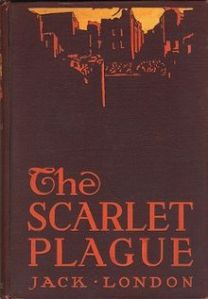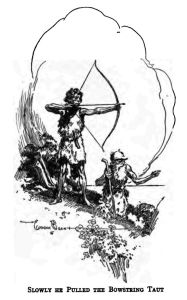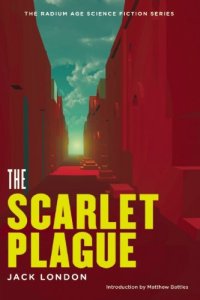Jack London’s The Scarlet Plague (1912)
 We’re all familiar with classic scenes of a brutal post-apocalyptic world like this: A group of refugees from the pandemic is holed up in an abandoned building with a cache of food and arms, firing on a gang of assaulting raiders. Or, a former professor of English Literature, clad in goat skins and huddled around a fire, is telling his dirty, illiterate grandsons about life before civilization vanished.
We’re all familiar with classic scenes of a brutal post-apocalyptic world like this: A group of refugees from the pandemic is holed up in an abandoned building with a cache of food and arms, firing on a gang of assaulting raiders. Or, a former professor of English Literature, clad in goat skins and huddled around a fire, is telling his dirty, illiterate grandsons about life before civilization vanished.
Today these scenes are standard fare in post-apocalyptic fiction, from The Road to The Walking Dead. But when Jack London wrote them a century ago, they weren’t. The genre itself had been around for a long time, and many of the classic themes, settings, and catastrophes had already been introduced. However, nobody before Jack London had described a collapse of civilization so violent or an aftermath so squalid. In the century since, images of a gritty and brutal world in ruins have become almost a requirement in this genre.
RISE AND FALL
Nobody should be surprised that the author of The Call of the Wild wrote a gritty post-apocalyptic novel. London was part of the naturalist literary movement, whose writers were influenced by Darwinism and aimed to write non-sentimental, realistic depictions of the world in all its harshness. Five years before The Scarlet Plague, London had fused his naturalist style with his commitment to the Socialist movement in The Iron Heel, a novel about the violent rise of oligarchy in the U.S. and a forerunner of harsh dystopias like It Can’t Happen Here and 1984. The Scarlet Plague, though much less political, is likewise influenced both by London’s naturalism and his social ideals: the collapse of civilization comes about through an evolutionary process created by the capitalist machine.
 The storyline of The Scarlet Plague is straightforward. Professor James Howard Smith was once part of the social elite, as a member of the faculty of English Literature at the University of California, Berkeley. He’s now an elderly member of a primitive tribe that lives near the ruins of San Fransisco. Sitting around a campfire on an empty beach, he is telling his ignorant, abusive, and disbelieving grandsons about the world as it was sixty years earlier in 2013, right before the plague.
The storyline of The Scarlet Plague is straightforward. Professor James Howard Smith was once part of the social elite, as a member of the faculty of English Literature at the University of California, Berkeley. He’s now an elderly member of a primitive tribe that lives near the ruins of San Fransisco. Sitting around a campfire on an empty beach, he is telling his ignorant, abusive, and disbelieving grandsons about the world as it was sixty years earlier in 2013, right before the plague.
In that year there were eight billion people crowding the world (that’s London’s single good prediction in this book), and capitalism was thriving. America had become an oligarchy, ruled by a hereditary Board of Magnates. For the elite members of society like Smith, life is good. But the end begins when the Scarlet Plague breaks out in New York. The first signs of the disease are red blotches over the victim’s skin, and death follows within hours, or even minutes. The plague spreads rapidly, scientists are unable to stop it, and it finally reaches California.
 Smith tells his grandsons about how things quickly fell apart in Berkeley. The first signs of total collapse were the severed bonds of kin and friendship that snapped when the symptoms of the plague appeared. The President of the Faculty turns Smith away from his office, knowing that Smith had been exposed to an infected student. Smith himself refuses to admit his own brother into his home when he sees the telltale blotches on his brother’s face. People try to escape the city, while gangs of armed looters engage in firefights in the streets.
Smith tells his grandsons about how things quickly fell apart in Berkeley. The first signs of total collapse were the severed bonds of kin and friendship that snapped when the symptoms of the plague appeared. The President of the Faculty turns Smith away from his office, knowing that Smith had been exposed to an infected student. Smith himself refuses to admit his own brother into his home when he sees the telltale blotches on his brother’s face. People try to escape the city, while gangs of armed looters engage in firefights in the streets.
But all efforts to survive are pointless — the plague is thorough and indiscriminate, leaving only a handful of people who turned out to be resistant. They include include Professor Smith and a former chauffeur who became the founder of the “Chauffeur” tribe. The largely empty land is now inhabited by small bands of primitive tribes, descended from these few survivors and living squalid, brutish lives.
UNNATURAL SELECTION
Despite the deceptively simple storyline, The Scarlet Plague is a subtle book, though it took me a second reading to appreciate it. Many of the book’s ironies are embodied in Professor Smith. Though a member of the elite, Smith is aware of the injustices of society; nevertheless, he holds on to his class prejudices decades after that society fell. As he tells his story, it’s clear that Smith is by no means objective. He despises the chauffeur, who was also the grandfather of one of Smith’s grandsons. “Your grandsire was a chauffeur, a servant, and without education. He worked for other persons,” Smith tells him. “But your [formerly wealthy] grandmother was of good stock, only the children did not take after her.”
Smith considers it an injustice that a brute like the chauffeur was spared:
All he could talk about was motor cars, machinery, gasoline, and garages—and especially, and with huge delight, of his mean pilferings and sordid swindlings of the persons who had employed him in the days before the coming of the plague. And yet he was spared, while hundreds of millions, yea, billions, of better men were destroyed.
 Of course Smith himself was the beneficiary of blind luck as well, and if anything, his education in English literature leaves him much less suited to survive in the present world than the chauffeur.
Of course Smith himself was the beneficiary of blind luck as well, and if anything, his education in English literature leaves him much less suited to survive in the present world than the chauffeur.
Smith’s contempt for the chauffeur is not completely unjustified. The chauffeur, now deceased, really was a brute who used to beat his wife, who before the plague was married to one of the ruling oligarchs. He also established a culture of violence in the tribe. As Smith tells it, the chauffeur is the result of the unnatural selection produced by the capitalist machine, which created a savage underclass that made the fall and its aftermath so much worse:
In the midst of our civilization, down in our slums and labor-ghettos, we had bred a race of barbarians, of savages; and now, in the time of our calamity, they turned upon us like the wild beasts they were and destroyed us.
There was another selection process that worked in parallel. The increasingly crowded population, a result of industrialization, urbanization, and abundant production of food, was a ripe target for wave after wave of ever-more virulent plagues. Each wave was beaten back by the bacteriologists, but it was only a matter of time before the Big One arrived:
There were warnings. Soldervetzsky, as early as 1929, told the bacteriologists that they had no guaranty against some new disease, a thousand times more deadly than any they knew, arising and killing by the hundreds of millions and even by the billion. You see, the micro-organic world remained a mystery to the end.
And so technological society, with all of its accomplishments, brought about its own destruction.
 The Scarlet Plague reminds us that, despite what we see as progress, our place in the world is still vulnerable. Technological progress may bring a better life, but it also masks the underlying structural weakness, and one day, the whole edifice may fail catastrophically. “All man’s toil upon the planet was just so much foam,” Smith tells us, washed away in the inevitable flood.
The Scarlet Plague reminds us that, despite what we see as progress, our place in the world is still vulnerable. Technological progress may bring a better life, but it also masks the underlying structural weakness, and one day, the whole edifice may fail catastrophically. “All man’s toil upon the planet was just so much foam,” Smith tells us, washed away in the inevitable flood.
It’s not a particularly original theme, and it’s easy to read The Scarlet Plague as an overly simplistic moral fable. And in some ways it is overly simple — we’re clearly not supposed to take Smith’s words at face value, but London isn’t entirely convincing; too often his characters are merely stock types.
But what makes this a good post-apocalyptic novel are the gritty brushstrokes by a master of naturalism, which showed the collapse of civilization as the truly horrifying experience that it would be.
Read more entries in my post-apocalyptic science fiction series, and my other science fiction reviews.
 This review is part of Vintage Science Fiction Month. Head on over to the Little Red Reviewer to read more reviews of great early science fiction for the entire month of January.
This review is part of Vintage Science Fiction Month. Head on over to the Little Red Reviewer to read more reviews of great early science fiction for the entire month of January.
Image credits: The Scarlet Plague cover art from the Internet Speculative Fiction Database: Cover, 2012 HiLo Books edition by Michael Lewy. Illustrations from the original edition are via Project Gutenberg.

As always, great review and thoughtful analysis. I have this one on my shortlist so I can finish off London’s third major SF work, and your review makes it sound very interesting.
Thanks! You should definitely round out your reviews of Jack London’s SF. I haven’t read Before Adam. But I liked Scarlet Plague better than The Iron Heel – London’s social idealism is more subtle in this later work, IHMO.
Seems as though London is usually not considered a Sci-fi author by very many people. I’ll have to see if I can find this book.
He also wrote The Iron Heel, a dystopian novel, and Before Adam, a prehistoric novel. Admiral Ironbombs (see comment above) has great reviews of both of the books on his vintage pulp fiction site.
I am now following the Admiral’s blog, as well as the Little Red Reviewer!
They’re great blogs, on my must-read list. I always find great new reading recommendations there.